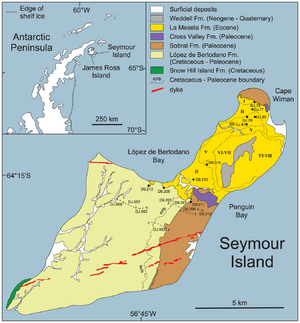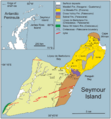Seymour Island facts for kids
|
Antarctic Peninsula
|
|
| Geography | |
|---|---|
| Location | Antarctica |
| Coordinates | 64°14′S 56°37′W / 64.233°S 56.617°W |
| Archipelago | James Ross Island group |
| Administration | |
|
None
|
|
| Demographics | |
| Population | 0 |
Seymour Island, also known as Marambio Island, is an island in Antarctica. It is one of 16 main islands near the tip of the Antarctic Peninsula. This area, called Graham Land, is the closest part of Antarctica to South America.
Seymour Island is located near Snow Hill Island, James Ross Island, and Vega Island. It is sometimes called Marambio Island because of the important Argentine base located there.
Contents
A Place of History
On the southern coast of Seymour Island, at Penguins Bay, you can find a special wooden plaque and a pile of rocks called a cairn. These mark an important event from over 100 years ago.
The plaque was placed on November 10, 1903. It was put there by the crew of an Argentine ship, the Uruguay. They were on a mission to rescue members of the Swedish Antarctic Expedition. This expedition, led by Otto Nordenskiöld, had gotten into trouble.
The plaque shows where the two groups met. It says: "10.XI.1903 Uruguay (Argentine Navy) in its journey to give assistance to the Swedish Antarctic expedition". In January 1990, Argentina built the rock cairn next to the plaque. This was to remember the same rescue. This spot is now a Historic Site or Monument (HSM 60).
Marambio Base: An Antarctic Hub
Seymour Island is home to the Marambio Base. This is the main Argentine base in Antarctica. It has an airfield that can be used all year round for planes with wheels.
During winter, about 55 people live at the base. In the summer, the number of people can grow to 180. This base is very important for research and travel in Antarctica.
Antarctic Weather
The weather on Seymour Island can be very cold. At Marambio Base, the average temperature in summer is about 1°C (34°F). In winter, it drops to around -21°C (-6°F).
Strong winds in winter can make it feel much colder. The wind chill can make the temperature feel as low as -60°C (-76°F) on your skin!
On February 9, 2020, a record high temperature for the Antarctic region was recorded here. It reached 20.75°C (69.35°F). This broke the old record from 1982.
Amazing Fossils
Seymour Island is like a "Rosetta Stone" for understanding Antarctica's past. The rocks on the island are very old, mostly from the Late Cretaceous and Eocene periods. Scientists study these rocks to learn about Earth's history.
Many different rock layers are found here. These include the López de Bertodano Formation, Sobral Formation, Cross Valley Formation, and La Meseta Formation.
Discovering Ancient Life
In December 1892, a Norwegian captain named Carl Anton Larsen landed on Seymour Island. He found more than just maps. He discovered fossils of animals that lived long ago and are now extinct.
Since Larsen's trip, scientists have studied the island's paleontology. This is the study of ancient life through fossils.
The End of the Dinosaurs
Seymour Island has rocks that show the Cretaceous-Paleogene boundary (K-Pg). This is the time when dinosaurs and many other species died out. Scientists believe a giant space rock hit Earth around this time.
At this boundary on Seymour Island, there's a small amount of iridium. This metal is rare on Earth but common in space rocks. It supports the idea of a large impact. Right above this layer, scientists found many fish fossils. These fish likely died because of the changes to the environment after the impact.
Studies from Seymour Island show that a huge mass extinction happened in Antarctica, just like in other parts of the world.
A Warmer Past
Seymour Island also helps us understand the Eocene period. During this time, Earth was cooling down, which eventually led to Antarctica becoming covered in ice.
However, the middle of the Eocene had a short period of warming. Because of this warmer climate, Seymour Island once had a much richer ecosystem. It was full of different kinds of flora (plants) and fauna (animals).
Scientists have found many amazing fossils from this warmer time. These include:
- Extinct penguin species, like Palaeeudyptes klekowskii and Archaeospheniscus wimani.
- Various types of bivalves (shellfish).
- Many different kinds of plants and animals.
Ancient Mammals
In 1982, scientists found a fossil of an extinct marsupial on Seymour Island. This was the first proof that land mammals once lived in Antarctica!
Since then, more mammal fossils have been found. These include ancient relatives of opossums and other unique animals. Some of these ancient mammals were ungulates (hoofed animals). One fossil might even be Sudamerica ameghinoi, a very old and mysterious mammal.
Island Features
- Bertodano Bay
- Cross Valley
Images for kids
See also
 In Spanish: Isla Seymour para niños
In Spanish: Isla Seymour para niños




